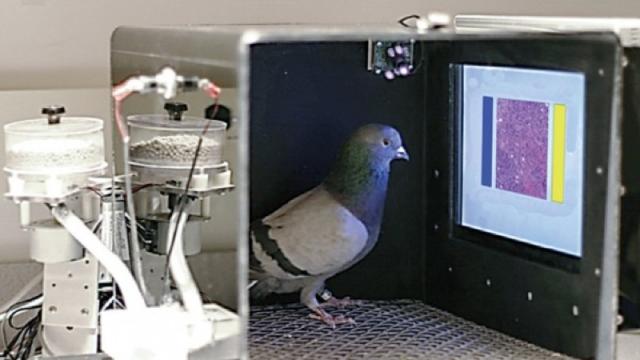There’s a long, colourful history of using pigeons in research, particularly in the behavioural and psychological sciences. Now scientists have trained a flock of pigeons to be feathered pathologists, able to spot telltale signs of breast cancer in medical images nearly as well as their human counterparts.
As reported in paper published this week in PLOS One, Richard Levenson and University of Iowa psychologist Edward Wasserman showed their chosen pigeons images of tissue samples that were either benign or malignant, and the birds would peck on blue or yellow rectangles on a touch-screen monitor to indicate their choice. When they chose correctly, they received a treat. John Bohannon at Science offers more details:
[R]esearchers had 16 pigeons do all their learning once per day in a box with a computer screen without humans visible. Previously diagnosed histopathology slides from biopsies of breast tissue appeared on a computer touchscreen along with a yellow and a blue button. If the birds correctly identified cancer, they were automatically rewarded by the computer with a food pellet. If they were wrong, they got nothing. The computer not only randomised the order of images from benign or malignant tissue, but also whether yellow or blue signified “cancer” for any particular bird, to make sure the colour itself didn’t introduce bias. And to ensure they weren’t just memorising the slides, the birds were challenged with images of the same tissue with different magnifications and colour.
The pigeons didn’t do very well at first, making correct identifications roughly 50% of the time. But after two weeks of regular training, they were able to correctly identify benign or malignant tissue 85% of the time. That was just for individual pigeons. Next the researchers used a technique called “flock sourcing,” whereby the pigeons were grouped together and required to “vote” on their answers. The teamwork paid off: the pigeon pathologists upped their accuracy to an impressive 99%, comparable to trained humans.
Why pigeons? It seems our feathered friends share similar properties of the visual system with us, so they are useful models for, say, helping to improve medical imaging technology. Besides, “They are workaholics,” Wasserman told Discover‘s D-Brief. “They work for peanuts. Well, not really, because peanuts are too big.”
You probably won’t find pigeons replacing hospital pathologists the next time you go in for a mammogram, however. Like their human counterparts, the birds struggled to correctly identify images with differences in colour and compression. And a human pathologist is able to make contextual decisions in a way even a flock of pigeons cannot. We could one day see a pigeon-based artificial neural network, however, capable of diagnosing these kinds of medical images.
References:
Levenson, R.M. et al. (2015) “Pigons (columba livia) as trainable observers of pathology and radiology breast cancer images,” PLOS One 10(11): e0141357.
Watanabe, S. et al. (1995) “Pigeons’ Discrimination of Paintings by Monet and Picasso,” Journal of the Experimental Analysis of Behaviour, vol. 63, 1995, pp. 165-174.
[Via Improbable Research]
Images: R.M. Levenson et al./PLOS One.
